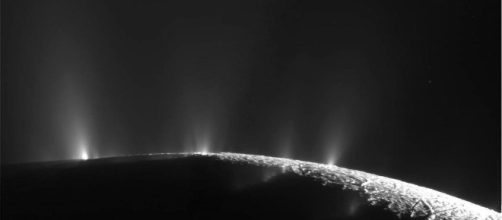NASA has announced that recent findings thanks to the Cassini mission to Saturn, the Galileo mission to Jupiter, and recent observations of Europa by the Hubble Space Telescope that point to the possibility of life on the ocean worlds of the outer planets.
Cassini, which recently passed through the water plumes erupting from the icy surface of Enceladus, detected hydrogen gas. The hydrogen is thought to be from hydrothermal activity spewing from the ocean floor beneath the ice crust of the Moon Of Saturn.
Scientists speculate that microbes that may live in the subsurface ocean may be able to use that hydrogen combined with carbon dioxide dissolved in the water of the ocean to create energy and methane as a byproduct.
The process is the basis of microbial life on Earth. Scientists have detected almost all of the elements of life on Enceladus, except phosphorus and sulfur, but suspect that these elements are likely present on the ocean floor of the moon of Saturn. Thus Enceladus has all the elements needed for life, water, heat (in the form of tidal energy from Saturn) and organic elements.
The other big discovery was accomplished by the Hubble observing what was probably a plume erupting from the surface of Europa, a Moon Of Jupiter. Europa, like Enceladus, is thought to have an ocean beneath an ice crust. The plume on Europa, unlike Enceladus, is thought to erupt intermittently. NASA will not completely confirm a plume on Europa but is increasing confident that it exists.
The possible Europa plume seems to coincide with a thermal anomaly beneath the icy crust. Scientists speculate that the hot spot is causing the plume to break through the surface of the moon of Jupiter. The heat may be generated by tidal forces from Jupiter squeezing and releasing the ocean floor of Europa as well as its icy shell.
The significance of a plume from beneath the icy surface of Europa means that material from the subsurface ocean is being spewed up and then deposited on the surface of the moon of Jupiter. That means that the area around the plume would be a prime area for the upcoming Europa Clipper mission to observe and characterize the material deposited on the surface to determine what makes up the subsurface ocean.
The Europa Lander may touch down in that area as well, depending on funding and whether or not the terrain is suitable or not.
For decades, the search for extraterrestrial life has focused on Mars. Now, that quest has shifted outward toward the ocean worlds of the outer planets.

